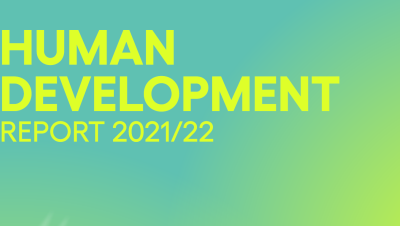Informal employment – informality - is everywhere in the developing world. Although it provides badly needed jobs for the poor, it harms workers’ protection, earning predictability and social benefits. It also reduces the tax base. And so understanding the informal economy is critical if one wants to better understand the political, economic and social ecosystem around sustainable human development. Think of the “Arab spring”, which began in Tunisia in 2010 when Mohamed Bouazizi, a young street trader set fire to himself in protest at his continued harassment and humiliation by the police.
Despite its importance few have looked closely at the informal economy. It remains largely ignored by researchers and neglected by politicians, and often perceived as something that is supposed to fade away as development happens. This perception is hazardous indeed: many “developed” societies are facing a new wave of informalization fueled by the liberalization of labor markets and the digital revolution (for instance the unregulated sharing economy involving companies like Uber).
This article presents some of the findings from our book The Informal Economy in Developing Countries, an empirical analysis covering Asia, Africa and Latin America ).1
An important first question to ask is why do people take an informal job?
The case of Vietnam, as represented in figure 1 below, shows that job satisfaction in the informal sector is low. The public sector seems to provide the most satisfaction to workers as nearly three workers out of four (72%) declare themselves satisfied or very satisfied with their job. Workers in the informal sector and in agriculture report the most dissatisfaction, with fewer than 40% of workers satisfied with their work in these sectors.
Between brackets: balance of satisfaction = percentage of (“very satisfied” + “satisfied”) minus percentage of (‘“very unsatisfied” + “unsatisfied”).
Working in the informal sector, with its lower benefits and poorer working conditions, seems, not to be a desire for the majority of Vietnamese workers outside of the farming sector. It is more likely seen as a temporary phase for workers seeking a formal job or leaving agriculture. The graph illustrates a “dual” approach to the labor market which seems to operate whatever the level of development reached by countries.
A second finding in our book relates to the economic, institutional and social constraints faced by informal workers in developing countries, such as corruption, inefficiency of the production process and barriers, such as red tape and burdensome legislation, preventing them integrating into the formal economy. Yet not all informal workers are the same: “multi-segmentation” is a key feature of the informal economy everywhere, in which a relatively well-off small group of successful individual enterprises coexists with the vast majority of smaller, less successful enterprises operating in precarious conditions and struggling to survive. The latter are often trapped in hardship by barriers preventing their access to things such as credit or training.3
The link between social capital and the informal economy is also important, but again has been little studied by economists. Our analysis reveals that social bonds play a role which is either
- positive if the networks help to compensate the imperfections in the labor and capital markets or
- negative if forced solidarities (especially financial transfers) are imposed within the family and community, which prevent informal businesses to develop.
Ultimately, documenting the dynamics of the informal economy remains a major challenge. Over the long run, the dynamics of the informal sector are driven by demographic, economic and public policy determinants. South America is a striking case in point. During the 1980s, the “lost decade” of recession and low economic growth resulted in little change in the size of urban informal sector (in part because of a slowdown in population growth). During the 1990s, in spite of economic recovery, structural adjustment policies contributed to a huge increase of employment in the informal sector (and poverty more generally). But, at least until the global financial crisis, the strong economic growth at the start of this century resulted, for the first time, in a significant reduction in the urban informal sector.
Looking at the mobility between formal and informal sectors and the link between informal employment, income and poverty can help us understand further these dynamics.
Poverty and informality are strongly correlated. And so, development policies would do well to help people make the transition from informal to formal employment. However this will take time and so, a two pronged strategy is needed which aims also to increase the incomes (through increased productivity, better access to credit, etc.) and living conditions (especially social protection) of those working in the informal sector.
To sum up, we have a few key-messages.
First, there are profound similarities among the informal sectors in developing countries. Those working informally typically have
- little education (the average number of years of schooling in the informal sector in West African capitals is less than 4 years, compared to 9 years in the formal sector);
- precarious jobs, with mediocre incomes and hazardous working conditions;
- and work in small – atomized - production units that are not well integrated into the formal economy.
Notwithstanding these stylized facts it is important also to understand that the informal economies of different countries are often very different.
When the formal labour market cannot provide a livelihood to those wanting to work, the informal sector offers a refuge for workers, even in emerging countries. In developed countries, new forms of informal employment are appearing. Indeed, informality challenges human development everywhere.
Jean-Pierre Cling is special advisor at the French ministry of Foreign Affairs and International Development*. Mireille Razafindrakoto and François Roubaud are senior research Fellows at DIAL, Paris (Institut de Recherche pour le Développement-Paris Dauphine University Research Unit). *This blog post expresses his own personal views and not necessarily those of the French ministry of Foreign Affairs and International Development.
Footnotes1Cling J.-P., Lagrée S., Razafindrakoto M. and Roubaud F. eds. (2014) The Informal Economy in Developing Countries, Oxford and New York: Routledge, 364 p.
2Razafindrakoto M., Roubaud F. and Wachsberger J.-M. (2014) Working in the informal sector; A free choice or an obligation? An analysis of job satisfaction in Vietnam, in Cling J.-P., Lagrée S., Razafindrakoto M. and Roubaud F. eds. The Informal Economy in Developing Countries, Oxford and New York: Routledge.
3de Soto, H. (1994) The Other Path: The Invisible Revolution in the Third World. New York: Harper Collins (original edition published in Spanish in 1986).
4Verdera F. (2014) Do limits exist to informality growth in South America? A preliminary exploration, in Cling J.-P., Lagrée S., Razafindrakoto M. and Roubaud F. eds. The Informal Economy in Developing Countries, Oxford and New York: Routledge.
5Cling J.-P., Nguyễn Thị Thu Huyền, Nguyễn Hữu Chí, Phan T. Ngọc Trâm, Razafindrakoto M., Roubaud F. (2010) The Informal Sector in Vietnam: A focus on Hanoi and Ho Chi Minh City, Hanoi: Thê Gioi Publishers.
6Herrera J. and Hidalgo N. (2014) Dynamics of Informal Microenterprises and Poverty in Peru: A Panel Approach , in Cling J.-P., Lagrée S., Razafindrakoto M. and Roubaud F. eds. The Informal Economy in Developing Countries, Oxford and New York: Routledge.
The HDialogue blog is a platform for debate and discussion. Posts reflect the views of respective authors in their individual capacities and not the views of UNDP/HDRO.


